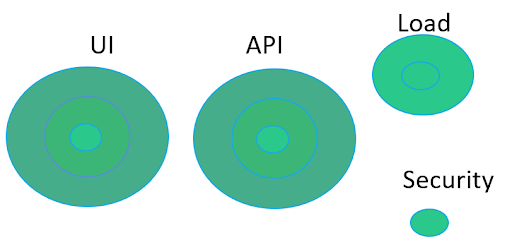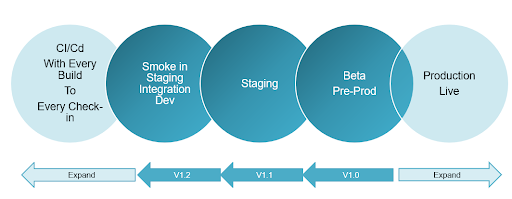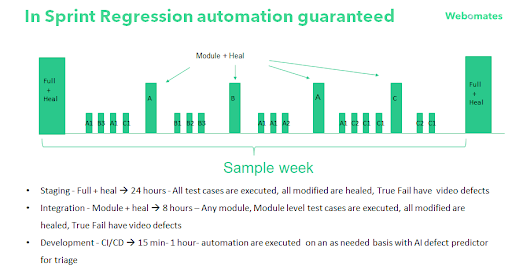Change is the only constant.
This applies to Software Testing more now than ever. Organizations are continually evolving and transforming by finding innovative ways to incorporate emerging technologies with a vision to ramp up quality.
While the Last gen used the Waterfall model, the current gen is using Agile model to enable faster delivery and quicker ROI. As part of this digital transformation, organizations – large and early-stage startups – are now moving towards DevOps and including CI-CD as a basic process to enhance its quality engineering efforts and enable early defect detection to reduce costs and time investments.
The software development teams now rapidly need to move towards Shift-left testing to fix the defects at a fast pace and increase feature velocity. Continuous Testing is another demand which needs to be involved as part of Shift-left testing to fix problems at an early stage and expedite feature velocity.
So what exactly is Shift-Left Testing?
Ten years ago, shift-left was a nouveau concept. It was originally introduced in 2001 by Larry Smith in his article in an effort to integrate the Quality Control(QC) and development parts of a software project. As the name implies, Shift-left testing is an approach to software testing and system testing in which testing is performed earlier in the life cycle (i.e. moved left on the project timeline).

Early testing helps to reduce the number of defects found. Prevention of defects escaping production) is better than a cure (defect fixes), especially when the cure is costly. You can extract maximum benefit out of this approach by using the two key DevOps practices: Continuous Deployment and Continuous Testing. Shift-Left is also about breaking down silos. It is a blessing in disguise as it gives an opportunity for bridging the gap between development and testing as it reduces the feedback time between the teams.
And why do we need it?

A traditional product life cycle involved Development and QC teams work in silos around base-levels – Development team developed a ‘base-level’ and passed it over to QC team who would test it and revert with defects and feedback to the development team.
A time-consuming loop that organizations wanted to end after realizing the immense potential of the emerging technologies.

The cost of fixing a defect rises exponentially as you move closer to production. According to an IBM survey, research from the National Institute of Standards and Technology & the Ponemon Institute found that if vulnerabilities get detected in the early development process, they may cost around $80 on an average. But the same vulnerabilities may cost around $7600 to fix if detected during the production phase.

It’s not just about the cost benefits. Imagine releasing a product with bugs.

Have you heard about the infamous Lloyds TSB – the British bank’s IT migration failure due to fundamental difficulties in performing functional and non-functional testing within expected timelines?

In such volatile market conditions and ruthless competition all around, damage to the company’s reputation and a loss of customer satisfaction goes a long way and is hard to be regained.
And this is what we are trying to avoid by going with the Shift-Left approach. So, Shift-Left or get behind.
The Design Mantra: Shift-Left your Testing Days with Webomates CQ
With a goal to help organizations achieve accelerated feature velocity, Webomates – a cloud-based testing platform powered by AI, embeds the Shift-Left approach and carries out software features and regression testing in guaranteed timeframes. It has the expertise, framework and the tools to optimize your QC efforts.
- Fix bugs at design, less will go to development
It’s a myth that Shift-Left testing means deploying the same test strategy, only earlier.
Shift-left testing is a continuous endeavor in collaboration from development and QC teams.

Webomates CQ becomes an integral part of the product development life cycle, right from the development phase enabling early defect identification in requirements, architecture, and design, thus giving a chance to change/improve the feature.
When developers are still in the code writing stage, you start with UI testing and API testing but with mini suites targeting the area that the developer is working on. As the features develop, you then move on to module, integration and regression testing. If the module fails, there is no point for an integration test. The developers need to go back to the module and fix it before moving on. You do not wait till the end of the lifecycle to test the entire product.
- Scale up your testing
Webomates has proven records of exhibiting agility in scaling up its testing services based on the changing requirements. Shift-left approach helps in building a good product where UI, API, Load and Security are not left out to be tested as a different component at the end.

- Build checks using Regression and Self Healing
Webomates focuses on getting build checks done via various regression services like FULL in staging environments, Overnight modular test suites at lower environments like integration, and mini test suites in Developer environments. And as the full regressions and modular tests include healing of the test cases and test scripts for modified features, the test suite is near UpToDate at all times.
With such stringent code quality checks, the overall code quality will improve hence ensuring a more stable end-product is delivered to the customer.

- Targeted mini suite test regressions
Defect discovery is shifted left with testing of existing suites (High priority scenarios) carried out in 3 environments to ensure that existing application is not broken:
- Staging: Every build goes through a full regression for 24 hours in staging or pre-production environment before release to production.
- Integration: Overnight module regression is used to test specific module-level changes and integrations with results delivered in 8 hours with a modified test package. Test cases that changed due to a defect fix or feature change were also validated. By using such targeted software regression, test defects were detected earlier in integration.
- Development: Webomates use mini regression suites that can be as granular as at the feature level with results delivered in 15 minutes to 1 hour.

Webomates thus helps the teams deliver higher quality releases while saving thousands of hours removing roadblocks and drag on productivity. With detailed defects along with analysis and video provided, the development teams can focus on the story points and deliver increased velocity. Read for more about:https://www.webomates.com/blog/agile-testing/shift-left-testing-in-agile/
Read Next










